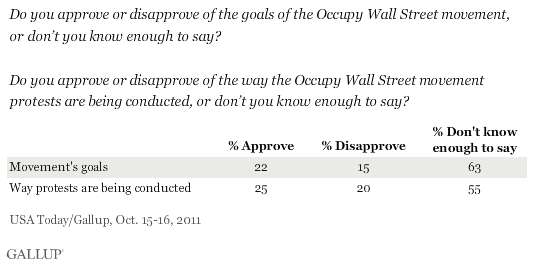Poll Watch: 22% Approve of Occupy Wall Street Movement’s Goals

Less than half of Americans express an opinion about either the Occupy Wall Street movement’s goals or the way it has conducted its protests. Those with an opinion are more likely to approve than disapprove.
The results are based on an Oct. 15-16 USA Today/Gallup poll. The Occupy Wall Street movement has attracted significant media attention for its nearly month-long protest of major U.S. financial institutions in New York, with similar demonstrations taking place in numerous other cities in the United States in recent weeks.
But the American public does not seem to be very familiar with the movement or its goals. Part of that may stem from the below-average level of attention Americans are paying to the news story. Fifty-six percent say they are following the story closely, including 18% who say very closely. The averages for more than 200 news events Gallup has tracked since the 1990s are 61% closely and 22% very closely.
Additionally, the lack of knowledge about the movement’s goals may be because the movement has not had clearly defined leaders or goals. Rather, it appears to be united by grievances against the wealthiest Americans — in particular, those who run major Wall Street financial institutions.
Republicans (57%), Democrats (57%), and independents (55%) are about equally likely to say they are following news about Occupy Wall Street closely.
Those who are closely following the news about Occupy Wall Street are more likely to approve than disapprove of the movement’s goals, but even among this more attentive group there is a substantial degree of uncertainty, 44%. That drops to 27% among the most highly attentive group, those who are following the story “very closely.” Among this group, 45% approve and 29% disapprove of the Occupy Wall Street movement’s goals.
It appears the American public by and large are neutral toward the Occupy Wall Street Movement. And, in contrast to the Tea party movement, the level of public support is about the same.
The poll sought to contrast support for Occupy Wall Street with another prominent American movement, the Tea Party. In the poll, 22% describe themselves as Tea Party movement supporters, 27% as opponents, and 47% as neither. Gallup has typically found that about equal percentages of Americans are Tea Party supporters or opponents, with the greatest percentage neutral. Thus, the current level of public support for Occupy Wall Street is similar to that for the Tea Party movement.
So, what are the implications?
Unclear.
To the extent the Democratic Party and its member POLS embrace the Occupy Wall Street Movement is unknown. And, how this influences the 2012 elections is also unknown.
However, the recent polling by the Wall Street Journal which provides some insight into the protesters might indeed exert some future influence on both who as elected representatives support them or how the public perceives them.
The protesters have a distinct ideology and are bound by a deep commitment to radical left-wing policies. On Oct. 10 and 11, Arielle Alter Confino, a senior researcher at my polling firm, interviewed nearly 200 protesters in New York’s Zuccotti Park. Our findings probably represent the first systematic random sample of Occupy Wall Street opinion.
Our research shows clearly that the movement doesn’t represent unemployed America and is not ideologically diverse. Rather, it comprises an unrepresentative segment of the electorate that believes in radical redistribution of wealth, civil disobedience and, in some instances, violence. Half (52%) have participated in a political movement before, virtually all (98%) say they would support civil disobedience to achieve their goals, and nearly one-third (31%) would support violence to advance their agenda.
The vast majority of demonstrators are actually employed, and the proportion of protesters unemployed (15%) is within single digits of the national unemployment rate (9.1%).